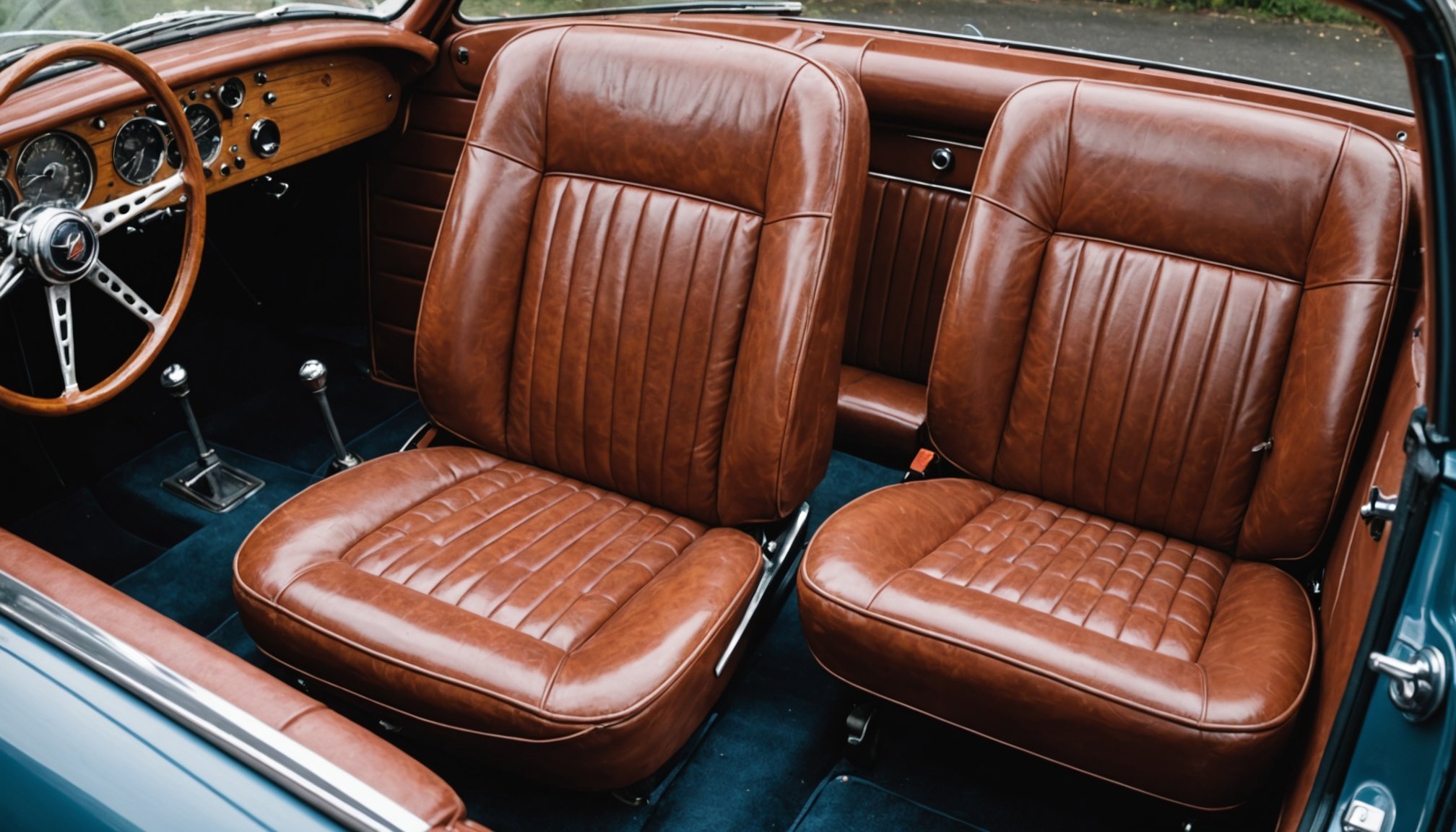Overview of Leather Seat Restoration
Restoring leather seats in classic UK cars is crucial for preserving the vehicle’s interior and enhancing its value. A well-executed restoration can transform seats, ensuring longevity and aesthetic appeal. To achieve this, a variety of materials and tools are necessary. Firstly, high-quality leather cleaners and conditioners specifically designed for automotive seats are essential for the initial cleaning process. Adhesives and fillers are vital for repairing splits and cracks. Sandpapers of varying grit help smooth out repairs, ensuring a seamless finish.
Besides these, leather dyes are crucial to match the original colour and blend repairs effectively. When choosing tools, seek ergonomic designs for ease and precision during the process. Excellent results depend significantly on methodical preparation and execution. Expect restored seats to regain their suppleness, colour, and texture, reviving the classic car interior’s original character. Moreover, maintaining these seats through regular cleaning ensures the leather remains vibrant and free from wear and tear. Restoration may seem daunting, but with the right approach and resources, the restoration can successfully preserve and enhance the timeless charm of leather interiors.
Also to see : Key legal considerations for car lift kit installation in the uk: your complete guide
Assessing Condition of Leather Seats
Before beginning leather seat restoration, accurately assessing the condition of the leather is crucial to formulating an effective plan. Identifying signs of wear, such as cracks, fading, or discolouration, helps determine the extent of repairs needed.
Techniques for Evaluating Leather Condition
To evaluate leather condition, start by visually inspecting the seat for any obvious damage. Feeling the leather can also reveal areas where it has become stiff or brittle. Use a magnifying glass for close inspection to detect smaller tears and abrasions. Testing the flexibility of the leather by gently attempting to fold it can highlight its current state. If the leather creases significantly, it may need additional treatments.
Have you seen this : Essential considerations for choosing the right windscreen replacement service in the uk
Repair or Replace?
Determining whether to repair or replace involves weighing the damage against the practicality and cost of restoration. Minor surface scratches and fading can usually be repaired with the right materials and techniques. However, if the leather is extensively cracked or torn, replacement might be more cost-efficient. For severely degraded leather, replacement ensures safety and longevity, particularly if the leather’s structural integrity is compromised.
Accurate condition assessment is the foundation for successful leather seat restoration, guiding whether a repair is feasible or a replacement is necessary.
Preparing for the Restoration Process
Ensuring thorough restoration preparation is vital for a successful project on your classic car’s interior. Begin by creating a dedicated, clean workspace to prevent contaminants from interfering with the restoration. This not only minimises mess but also ensures a focused environment.
Gathering necessary materials and tools is the next step. Assemble quality products such as leather cleaners, conditioners, and repair items like adhesives and fillers. Ensure you have sandpapers, leather dyes, and ergonomic tools ready to enable precision work. Preparing these items in advance helps streamline the process, allowing you to focus solely on the restoration.
Safety cannot be overlooked. Prioritise safety precautions to protect yourself from potential harm during the restoration. Wear gloves to shield your skin from chemicals and abrasives, and consider using a mask if you’re working in an enclosed area with strong solvents. Adequate ventilation is crucial when using certain products, further ensuring a safe working environment.
By methodically preparing your workspace and gathering all needed materials, along with prioritising safety measures, you’ll set the stage for a smooth and effective restoration experience.
Step-by-Step Restoration Techniques
Restoring leather seats involves key restoration techniques that ensure your classic car interior looks as good as new. These steps will guide you through the process, enhancing both the durability and appearance of your seats.
Cleaning the Leather
Start by using high-quality leather cleaners to remove dirt and oils from the surface. Apply the cleaner with a soft cloth, gently rubbing in a circular motion. This preparation is crucial for revealing the true extent of any damage and ensuring effective repair results.
Repairing Damage
For repairing tears and cracks, first use leather fillers to mend gaps and splits. Apply evenly, allowing it to dry thoroughly before proceeding. For deeper cracks, reinforce with suitable adhesives to maintain structural integrity. Sand the repaired areas with fine-grit sandpaper for a smooth finish.
Conditioning and Finishing
Once repairs are complete, it’s vital to condition the leather. Use a reputable conditioner to restore suppleness and maintain the leather’s natural oils. The final touch involves applying leather dye, carefully matching the original colour for a seamless finish. Finish with a protective sealant to guard against future wear.
Material Recommendations
Selecting the appropriate restoration supplies is vital for achieving an authentic and durable finish in your classic UK car’s interior. Classic vehicles often feature a variety of leather types, each requiring specific treatments. Opt for high-quality leather materials compatible with the vehicle’s original design. Traditional leather typically used in such cars demands gentle yet effective products for conditioning and restoration.
When tackling repairs, the right adhesives and fillers are crucial for addressing splits and cracks. Choose products known for flexibility and longevity to ensure repaired areas withstand regular use without detaching or cracking again. For the dying process, select leather dyes that closely match the original colour of the seats. This ensures a seamless and authentic appearance, crucial for maintaining a vehicle’s classic charm.
Completing the restoration requires precise selection of finishes to protect against UV damage and regular wear. These finishes not only enhance the leather’s natural sheen but also provide an essential layer of protection. By choosing top-quality materials and supplies, you ensure that your restoration achieves both authentic aesthetics and long-lasting durability.
Cost Estimation and Budgeting
Proper budgeting is key when embarking on leather seat restoration for your classic car interior. To manage your finances effectively, begin by itemising potential costs involved in the restoration process. Restoration costs vary based on the extent of damage, the specific materials required, and whether you choose to tackle the project independently or hire a professional.
Allocating a budget for tools and materials such as leather cleaners, conditioners, dyes, and repair kits is essential. Purchasing high-quality products may seem costly upfront, but it ensures a durable and more aesthetically pleasing result, potentially saving money in the long term by reducing reconditioning needs.
For DIY enthusiasts, adopt cost-saving tips like sourcing materials during seasonal sales or considering buying from discount suppliers. Additionally, estimate labor costs if you plan to hire professionals for intricate repairs, balancing quality with affordability.
To further optimise your budget, seek community support. Engaging with online forums can provide valuable insights into affordable product options and recommendations from experienced restorers. A well-kept budget not only safeguards financial expenditure but also ensures the successful rejuvenation of your leather seats.
Maintaining Revitalized Leather Seats
Preserving the quality of revitalized leather seats is critical for maintaining the classic car interior’s appeal. Regular leather maintenance is essential to extend the longevity of your restoration efforts and keep the leather looking fresh and supple.
Recommended Care Routines
Establish a routine that includes cleaning your seats at least once a month with a mild leather cleaner. This helps remove dirt and oils that could degrade the leather. Follow up with a high-quality conditioner to nourish and maintain the leather’s natural oils, preserving its flexibility and sheen.
Products for Optimal Care
Select products specifically designed for leather car interiors. Look for pH-balanced cleaners and conditioners, as these are gentle yet effective on automotive leather. Maintaining a product selection that includes a protective sealant can safeguard against UV damage, which is crucial to prevent fading and cracking over time.
Tips for Preventing Future Damage
Preemptive measures are also vital. Protect leather seats from direct sunlight when possible, and consider using seat covers to shield them from excessive wear. Avoid using harsh detergents or alcohol-based products that can strip the leather’s essential oils, ensuring your leather seats remain beautiful over time.
Before-and-After Examples
Exploring restoration examples vividly demonstrates the transformation that meticulous leather seat restoration can achieve. Witnessing the visual transformation from worn to pristine captivates owners of classic cars, providing tangible evidence of the process’s effectiveness.
Showcasing Successful Restoration Projects
Owners often share their personal stories, highlighting the rejuvenation of their vehicles’ interiors. These stories are not just narrations; they strengthen the bond between car enthusiasts and their classic pieces. Photos illustrating the stages of restoration capture changes in colour vibrancy, texture enhancement, and the absence of previous damage, offering a clear testament to the craft’s impact.
Analyzing Impact on Aesthetics
The aesthetic changes brought by quality restoration are profound. Revitalized leather introduces an air of elegance and authenticity, which significantly enhances the vehicle’s value. Owners note the transformation extends beyond appearance, improving the interior’s overall atmosphere.
Engaging with these visual transformations can inspire classic car owners to embark on restoration projects themselves. Observing the revitalization of seats through well-documented examples underscores the potential benefits and encourages others to preserve their beloved vehicles’ interiors.
Additional Resources and Support
For those diving into restoration of classic car interiors, numerous resources can enhance learning and execution. Begin by exploring online forums and communities where experienced restorers share invaluable advice. Websites dedicated to classic car enthusiasts often host these forums, turning complex projects into collaborative efforts.
Where to Find Guidance
Step-by-step guidance is accessible through tutorials on platforms like YouTube and dedicated restoration blogs. These tutorials demystify leather seat restoration procedures with visual and practical instructions, increasing your chances of a successful finish.
Community and Professional Support
Participate in local workshops to gain hands-on experience directly from seasoned professionals. These workshops focus on practical techniques, enabling you to tackle restoration with confidence. Additionally, hiring professional services can be a wise choice, particularly for intricate repairs where precision is paramount.
Join online groups like classic car clubs which often organise meet-ups or events, offering opportunities to network and share insights on restoration challenges. These communities not only provide support but also foster a shared passion for preserving classic car interiors. With these resources, you’ll find the help you need to maintain your vehicle’s timeless appeal.






